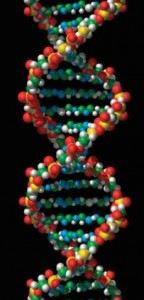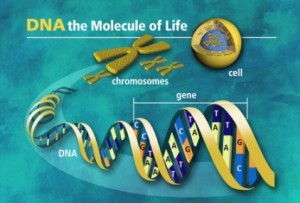
Every day, as we breathe in more oxygen, bathe in the sun’s radiation, and ingest chemicals found in our food supply, we are damaging the DNA in our cells. Over time, if uncorrected, this daily onslaught can lead to potential problems such as cancer. Thankfully, the human body possesses a remarkable repair mechanism to address this issue. Researchers from the University of Texas Medical Branch have now discovered how that mechanism, an enzyme called NEIL1, may prove useful in the fight against cancer and age-related disorders such as Alzheimer’s and Parkinson’s disease.
The findings, published in the Proceedings of the National Academy of Sciences, describe the enzyme as a ‘cowcatcher,’ aptly named after an old device fixed to the front of locomotives. Like the device, which works by clearing the track of any debris (such as a cow), the enzyme searches for genetic errors. Lead author Dr. Sankar Mitra elaborated to Science Daily, “Basically the replication train is coming and the cowcatcher is in front to see if any damage is present. If it finds such damage, the train moves backward, you repair it, and the train starts moving forward again.”
Conducting this train is a group of proteins called the pre-replication complex. When DNA replicates, the complex unzips its stable double helix structure, forming two split strands that act as templates in the formation of daughter cells. NEIL1 and its closely related cohort, NEIL2, are important members of this complex.

The process of separating the strands also exposes the body’s genetic blueprint, rendering it prone to attack from reactive oxygen species (ROS), which are natural byproducts of respiration. These oxygen-based free radicals wreak havoc by modifying the bases that make up DNA, creating base lesions. When overlooked, these lesions alter the original genetic code, culminating in a permanent mutation. If left unchecked, these mutations could manifest in a clinical disorder.
But with the presence of NEIL1 at the forefront of the pre-replication complex, the damage can be spotted. Once the enzyme locates a lesion on the DNA strand, it binds to it, signaling a halt to replication. The two DNA strands then realign, allowing for repairs to begin. After the corrections have been made, NEIL1 simply detaches. In the event that NEIL1 is unavailable, NEIL2 takes over.
The ramifications of this enzymatic activity are promising. Typical cancer treatments like ionizing radiation and antineoplastics kill cancer cells by damaging their genetic material. With suppressed NEIL1 expression, cancer cells will have a harder time defying these standard therapies because they lose the ability to repair their genomes. Since relapses occur when resistant cancer cells bounce back, suppressing NEIL1 expression can make the standard arsenal of cancer treatments more effective.

Conversely, NEIL1 can also be targeted to increase DNA repair. Boosting the expression of the enzyme can help combat ROS-induced damage in elderly patients, particularly in those who suffer from neurodegenerative diseases. The geriatric population is at increased risk for DNA damage because the repair mechanisms of aging bodies are not as robust or efficient.
For now, Mitra noted to Fox News, “We don’t know how to [directly] increase the level of this enzyme; however there are ways to increase its expression.” Indeed, by switching on or off certain genes, scientists may be able to harness the remarkable healing properties of this enzyme. With that hope, the researchers continue to explore DNA repair processes to further unlock their mysteries.
About the author:
Ansel Oommen is a freelance writer, multimedia artist, and senior toxicology student at St. John’s University. He regularly contributes to several databases including Bugwood Images and UC Berkeley’s CalPhotos.
